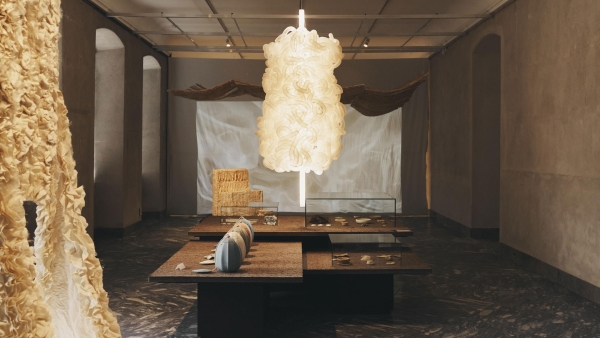From biodegradable urns made of potato starch to furniture made of hemp fibre,’Future is Present’ explores the changing face of design through the future’s perspective.
Design is layered with events from the past, mistakes of the present and hopes for the future. But when it comes to creating a particular reality based on what occurs right now, how aspirational is too aspiring? In the face of a world roasting on the skewers of mass fires, pandemics, refugee flows, population explosion, and deteriorating resources among other faceless issues, is it justified to redefine our moral and ethical codes, to design objects we don't need? An exhibition at the Design Museum, Denmark ventures upon a foreseeable future and the changing outlook of design from a present-day lens.
‘The Future is Present’ at the Design Museum, Denmark envisions a visually stimulating display of the changing objective design from the future. “The idea behind the exhibition from its onset was to create a dialogue between how designers and craftspeople in the past, have dealt with the future and how they tackle the theme today. We wanted to emphasise that the future is not some far away and abstract thing. It is something that happens now, and we are all a part of shaping it,” says Pernille Stockmarr, curator at Design Museum Danmark.
The exhibition, which places a strong emphasis on the three main topics of people, society, and the environment, virtuously avoids offering lengthy solutions to the complex issues that the world is currently facing. Instead; it shifts the spotlight on how designers, thinkers and creatives are working on shaping a better-designed future. In an eventful display, many different designers and experts peeled through the layers of creativity through experimental research and innovation. “We wanted the exhibition space to be a place of reflection, positivity, and creativity – showcasing some of the celebrated qualities of Danish design like material intelligence, poetic tactility along with a sensibility to human scale,” shares Stockmarr.
“We want to take the visitor by the hand, and guide them through explorations of creative boundaries, with a drive and approach to continuous questioning and enhancing as well as inspiring a perception of creative freedom in the future,’’ says Nikoline Dyrup Carlsen, Founding Partner at Spacon & X. The museum commissioned Spacon & X, a design and architecture studio based in Copenhagen, for creating the entire exhibition with a modern angle on the Danish design practice. Spacon & X is often known for pushing boundaries in terms of designing with new materials and spatial zoning which is precisely what they do with the creation of this neo-futuristic exhibition embodying the vast collection and history that the museum has to offer.
An air of hope for the future greets one as they enter the exhibition hall. The viewers are then surrounded by multiple objects with different tactile and material personalities all with one narrative: perceiving the future in the face of uncertainty. Throughout the exhibition, the viewers come across both organic and re-used materials and textiles that showcase innovative design solutions. Glass remains heavily celebrated with exhibits such as ‘Human intelligence’- a glass screen that upon staring, reflects on how focusing and thinking straight requires presence and quiet, or the ‘Glass Sphere’ that is placed strategically near a window to reflect the graphical views.
The "Vindur" garment, an extraordinary piece of clothing made out of woven silk and milk yarn and inspired by the fanciful flow of the wind, is where the designers most weirdly break down limits. Alongside, is the ethically questionable ‘Inside/Out’ lamp that poses a radical challenge blurring boundaries between art and design. The lamp is made of 100 metres worth of cow’s intestines as a response to utilising certain by-products. Another interesting exhibit is the MYX chair which is organically created using bio-based materials such as mushroom mycelia and hemp fibres.
The challenges and opportunities are uncountable but an exhibition such as this does make one wonder… What kind of world and life do we want? Can the practices of today, classifying design as an emergency while humanity heads towards “collective suicide” appertaining to the climate crisis, really decide how the future will be? Even though the exhibits might display a picture from the future, where humanity thrives on digital art and sustainable designs, one must not forget that more than just design, humanitarian and civic practices also holds importance for a better tomorrow. The ‘Future is Present’ instils a spark of concern about the hard-hitting reality and the crises which will shape an uncertain future if the world doesn't start acting on it soon. The collective display by the designers are pixels of a sustainable future.
The exhibition began on June 19, 2022, and will be up until June 1st, 2023 at the Design Museum Denmark
▪ Source: STIRpad | https://www.tongazakabun.co/items/66580273?fbclid=IwAR2ci1_nYwNyFhOJXnIVwkH8qBL3BnxR8NUwbFImHHOIbhztCys15v8OEMA
▪ Author: STIRpad
▪ Photography: Courtesy of Design Museum Denmark


